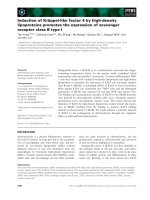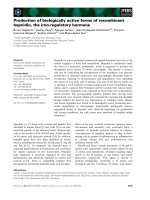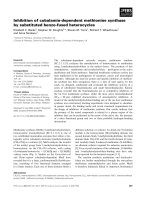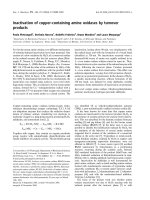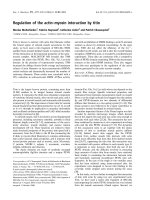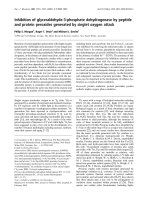báo cáo khoa học: "Production of viable hybrids in salmonids by triploidization" ppt
Bạn đang xem bản rút gọn của tài liệu. Xem và tải ngay bản đầy đủ của tài liệu tại đây (957.14 KB, 13 trang )
Production
of
viable
hybrids
in
salmonids
by
triploidization
B.
CHEVASSUS,
R. GUYOMARD,
D. CHOURROUT
Edwige
QUILLET
with
the
technical
assistance
of
G.
BURGER
and
A.
D
EVAUX
LN.R.A.,
Laboratoire
de
Physiologie
des
Poissons,
F
78350
Jouy-en-Josas
r
C.N.E.x.O.,
Centre
Oceanologie
de
Bretagne,
F
29273
Brest
Ce
d
ex
Summary
Rainbow
trout
eggs
were
fertilized
with
milt
collected
from
various
salmanids
(brown
trout
Salmo
trutta ;
brook
trout
Salvelinus
lontinaliv ;
coho
salmon
Oncorhynchus
kisutch)
and
heat-shocked
few
minutes
later
in
order
to
prevent
the
second
polar
body
extrusion.
This
operation
resulted
in
high
survival
rates
after
161
days :
respectively
49.2
p.
100,
66.2
p.
100
and
12.5
p.
100
of the
diploid
rainbow
trout
control
(basis
100
p.
100) ;
the
triploid
hybrid
constitution
of
these
fish
was
ascertained
by
karyological
and
biochemical
investigations.
These
data
contrast
with
the
bad
yields
of
the
corresponding
diploid
hybridizations
(no
heat
shock)
respectively
0
p.
100,
12.3
p.
100
and
0
p.
100.
Such
triploid
hybrid
salmonids,
that
are
easy
to
produce,
could
be
sterile
and
conse-
quently
of
a
great
interest
in
aquaculture,
where
fish
reproduction
often
makes
the
profi-
tability
decrease.
Key
words :
Hybrids,
triploid
y,
salmonids.
Résumé
Production
d’hybrides
viables
chez
les
salmonidés
par
triploïdisation
Des
ovules
de
truite
arc-en-ciel
Salnxo
gairdneri
ont
été
inséminés
par
du
sperme
de
divers
salmonidés
(truite
fario
Salino
trutta;
omble
de
fontaine
Salvelinus
fontinalis;
saumon
coho
Oncorhynchus
kisurch)
puis
soumis
à
un
choc
thermique
chaud
induisant
la
rétention
du
2’
globule
polaire.
Des
individus
viables
ont
été
obtenus
à
un
taux
élevé :
les
taux
de
survie
à 161
jours
rapportés
au
témoin
diploïde
arc-en-ciel
s’élèvGnt
respecti-
vement
à
49,2
p.
100,
66,2
p.
100
et
12,5
p.
100.
Les
données
caryologiques
et
biochimiques
indiquent
que
tous
ces
animaux
sont
des
hybrides
triploïdes.
Par
contre,
les
mêmes
croisements
non
soumis
à
un
choc
chaud
ne
produisent
qu’un
très
faible
nombre
de
survivants
(respectivement
0
p.
100,
12,3
p.
100,
0
p.
100)
identifiés
comme
des
hybrides
diploïdes.
Compte
tenu
de
leur
facilité
d’obtention,
les
hybrides
triploïdes
peuvent
se
révéler
des
animaux
intéressants
pour
l’aquaculture,
du
fait
notamment
de
leur
éventuelle
stérilité.
Mots
clés :
Hybrides,
triploïdes,
salmonidés.
I.
Introduction
Natural
occurrence
of
triploid
adults
in
fishes
was
evidenced
in
rainbow
trout
SalmO
gairdneri
(C
UELLAR
&
U
YENO
,
1972 ;
T
HORGAARD
&
GALL,
1979)
and
in
Poecilia
formosa
(S
ALSANO
et
al.,
1972).
In
the
case
of
an
interspecific
hybridization
leading
to
a
low
survival
rate,
the
frequency
of
allotrip,oidy
among
survivors
sometimes
seems
to
be
very
high,
as
demonstrated
by
CA
rANNA
et
al.
(1974)
in
Salmo
gairdneri
X
Sal-
velinus
fontinalis
hybrids,
by
M
ARIAN
&
K
RASZNAI
(1978)
and
V
ASILEV
et
al.
(1975)
in
some
cyprinids.
Besides,
in
the
former
and
the
latter
case,
the
karyotype
of
those
allotriploids
clearly
indicates
a
doubling
of
the
maternal
chromosome
set.
In
order
to
extend
these
observations,
it
seemed
to
be
of
great
interest
to
induce
a
triploidization
of
diploid
hybrid
germs
liable
to
early
abortion.
Triploidization
tech-
niques
consist
in
applying
thermal
treatments
to
the
eggs
a
few
minutes
after
fertilization,
in
order
to
prevent
the
second
polar
body
extrusion ;
in
that
way,
high
rates
of
triploidy
were
obtained
in
pure
species
(S
WARUP
,
1958,
in
stickleback ;
V
ALENTI
,
1975,
in
Tilapia ;
O
JIMA
&
M
AKINO
,
1978,
in
common
carp ;
C
HOURROUT
,
1980,
C
HOURROUT
&
Q
UILLET
,
1982,
in
rainbow
trout)
and
in
interspecific
viable
hybrids
(P
URDOM
,
1972
in
flatfishes).
In
the
present
studies,
unviable
hybridizations
in
salmonids
were
taken
as
a
model.
II.
Material
and
methods
A.
Fertilization
procedure
Eggs
from
12
female
rainbow
trouts,
Salmo
gairdneri
(GAT78-LN.R.A.
strain)
were
sampled
by
abdominal
pressure,
mixed
and
distributed
into
four
groups
of
about
1 500
eggs.
Each
group
was
fertilized
by
a
sperm
mixture
from
3
to
6
males
of
the
following
species :
-
rainbow
trout
Salmo
gairdneri
(RA
groups),
-
brown
trout
Salmo
trcstta
(BW
groups),
-
brook
trout
Salvelinus
fontinalis
(BO
groups),
-
Coho
salmon
Oncorhynchus
ki
s
utch
(CS
groups).
After
mixing
sperm
and
eggs,
50
CM
3
of
a
saline
buffered
diluent
was
added
(B
ILLARD
,
1977).
Fifteen
min.
after,
the
inseminated
eggs
were
transferred
in
normal
freshwater
for
incubation
in
a
recirculating
system
stabilized
at
10 °C ±
0,5
°C.
B.
Thermal
shock
The
triploidization
treatment
used
was
one
of
those
described
by
C
HOURROUT
&
Q
UILLET
(1982) :
Twenty
five
min.
after
the
beginning
of
incubation,
a
part
of
each
group
was
transferred
for
twenty
min.
in
a
26 &dquo;C
water
bath,
then
put
back
directly
into
the
incubation
system.
The
rest
of
the
eggs
were
kept
as
diploid
controls.
C.
Incubation
and
larval
rearing
At
the
end
of
the
incubation
period
(eyed
stage :
about
25
days
at
10
°C),
fertilized
eggs
were
numbered
and
transferred
into
the
experimental
fish
farm
of
G
OURNA
Y,
where
early
survival
rates
were
studied
up
to
161
days
after
fertilization.
D.
Karyological
methods
Karyological
investigations
were
performed
on
embryos
at
the
tailbud
stage
(day
17)
in
the
RA
and
CS
groups,
and
on
three
month-old
fingerlings
in
the
RA2,
B02,
RA3
and
BW3
groups :
Embryos
The
eggs
were
kept
for
six
hours
in
a
0.02
p.
100
colchicine
solution,
and
then
dissected
for
removal
of
the
embryo
in
0.7
p.
100
Nad.
Their
tail
was
submitted
to
a
hypotonic
treatment
(in
distilled
water)
lasting
15
minutes,
fixed
in
ethanol-acetic
acid
(3 : 1)
for
3
minutes,
and
rinsed
in
distilled
water.
The
tail
epithelium
was
gently
dissociated
on
the
slide
in
a
drop
of
50
p.
100
acetic
acid.
Fingerlings
They
were
kept
swimming
for
15
hours
in
a
0.01
p.
100
colchicine
solution.
After
killing,
the
gills
were
removed,
put
in
distilled
water
for
45
minutes,
fixed
3
minutes
and
then
dissociated
on
the
slide.
In
both
cases,
the
dissociated
cells
were
squashed
under
a
coverlip
that
was
imme-
diately
removed
in
50
p.
100
acetic
acid ;
after
rinsing
and
drying,
the
slides
were
stained
in
4
p.
100
Giemsa
for
10
minutes.
E.
Biochemical
studies
Starch
gel
electrophoresis
of
muscle
proteins
was
performed
on
20
presumed
7-
and
5-month-old
triploid
hybrids
from
CS3
and
BW3
groups,
respectively.
The
parents
of
CS
groups
were
also
studied.
Electrophoretic
conditions
were
described
elsewhere
(G
UYOMARD
,
1981).
III.
Results
A.
Viability
of
diploid
and
triploid
groups
Mortalities
during
the
experiment
are
recorded
in
table
1.
5
periods
were
studied :
P 1 :
from
fertilization
to
the
end
of
incubation
(D, -
D;!o),
P
2 :
hatching
period
(D31 -
D
13),
P
3 :
resorption
of
the
yolk
sac
(D44 -
D
tlo
),
P
4 :
feeding
start
(D61 -
Dj
05),
P
5 :
2
nd
and
3!
’(1
months
of
feeding
(D,,)!t -
D
161
)*
Results
can
be
summarized
as
follows :
RA
groups
In
the
diploid
controls,
mortalities
were
low
and
limited
to
the
resorption
and
feeding
start
periods
(P3 and
P4).
By
contrast,
the
RA3
group
exhibited
quite
high
mortalities
during
the
incubation
period.
P3
and
P4
were
also
critical
periods.
Later
on,
the
survival
rate
was
very
high.
BW
groups
The
hatching
rate
of
B’W2
was
very
high,
but
all
the
fry
died
before
feeding.
The
BW3
group
exhibited
a
lower
mortality
rate
during
this
resorption
period.
Later
on,
the
survival
of
the
fry
was
similar
to
that
of
the
RA2
control
group.
BO
groups
In
spite
of
high
mortalities
during
periods
P2,
P3
and
P5,
it
was
possible
to
obtain
a
few
survivors
in
the
B02
group
on
day
130.
These
survivors
were
killed
for
karyo-
logical
investigations.
Survival
in
the
B03
group
was
much
higher
during
P3
and
similar
to
the
controls
during
P4
and
P5.
CS
groups
Mortalities
were
high
since
fertilization
in
the
diploid
group,
leading
to
a
complete
elimination
at
the
end
of
P4.
Results
were
better
in
the
CS3
group.
Nevertheless,
mortalities
were
significantly
higher
than
in
RA2
controls
during
all
the
periods.
Table
2
indicates
the
results
for
all
the
periods
relative
to
the
RA2
control
group
(Normal
diploid
rainbow
trout).
It
clearly
demonstrates
the
increase
in
viability
resulting
from
triploidization.
B.
Karyological
investigations
The
karyological
examinations
performed
at
the
tailbud
stage
revealed
the
diploidy
(2n
=
60)
of
all
the
embryos
in
the
RA2
and
CS2
batches
(10
embryos
in
each
batch).
By
contrast,
all
the
analysed
embryos
of
the
heatshocked
RA3
and
CS3
batches
(20
embryos
in
each)
proved
to
be
triploid
(3n
=
90)
(fig.
1).
These
results
were
confirmed
in
survivors
three
months
after
fertilization :
15
fingerlings
from
RA2,
12
from
BW3
(fig.
2)
and
12
from
B03
were
analysed
and
provided
triploid
metaphases.
On
the
other
hand,
all
the
analysed
survivors
in
the
B02
group
(22
fingerlings)
proved
to
be
diploid
(fig.
3).
Because
of
small
variations
in
chromosome
counting,
it
was
not
possible
definiti-
vely
to
conclude
on
a
doubling
of
the
maternal
chromosome
set
in
triploid
hybrids,
even
in
BW3
and
B03
groups,
in
which
the
two
parental
species
exhibited
rather
different
chromosome
numbers :
2n
=
60,
80
and
84
for
rainbow
trout
(SIMON
&
DOLLAR,
1963),
brown
trout
(N
YGREN
et
al.,
1971)
and
brook
trout
(U
YENO
,
1972),
respectively.
C.
Biochemical
studies
Four
systems,
expressed
in
the
muscle,
were
chosen
for
hybrid
identification :
malate
dehydrogenase
(MDH - B),
phosphoglucose
isomerase
(PGI),
coded
by
two
and
three
loci
respectively
in
the
muscle
(see
MAY,
1980,
for
a
review
on
genetic
basis
of
isozymes
in
Salmonids),
cathodal
muscle
proteins
and
creatine
phosphokinase
(CPK,
previously
called
anodal
muscle
proteins).
Description
and
genetic
interpretation
of
CP K
in
salmonids
were
made
by
UTTER
and
al.
(1979).
These
four
systems
did
not
show
ontogenic
changes
between
end
of
resorption
and
adult
stage
and
were
already
used
for
diploid
hybrid
identification
(Gu
YON
tnR
D,
1978).
of
MDH
and
muscle
proteins
are
given
in
figures
4
and
6
and
their
interpretation
in
figures
5
and
7,
respectively :
-
Cathodal
muscle
proteins
and
PGI
were
used
for
the
BW
group.
These
two
systems
were
unvariant
in
parental
populations
and
clearly
revealed
the
hybrid
nature
of
BW
fry
(fig.
7).
-
CPK
and
MDH
appeared
to
be
fitted
for
studying
the
CS
group.
In
the
case
of
CPK
(fig.
7),
the
fry
were
obviously
hybrids.
Additionally,
in
the
case
of
MDH,
polymorphism
of
the
parents,
trigeny at
one
MDH
locus
and
the
presence
of
heterozygotes
for
maternal
alleles
at
this
locus
(fig.
4
and
5)
allowed
us
to
draw
two
additional
conclusions :
(i)
the
hybrids
were
triploid ;
(ii)
triploidy
was
obtained
by
a
duplication
of
the
maternal
genome
occurring
before
the
end
of
meiosis.
Discussion
and
conclusions
(1)
Fertilization
of
eggs
by
a
heterologous
sperm
may
a
priori
lead
to
several
different
events,
two
of
which
appear
more
frequently
(see
C
HEVASSUS
,
1983
for
a
review) :
-
a
gynogenetic
or
androgenetic
development
of
the
egg,
which
in
the
case
of
salmonids
results
in
an
unviable
haploid
embryo
(P
URDOM
,
1969 ;
A
RAI
et
al.,
1979) ;
-
a
real
karyogamy,
resulting
in
a
diploid
hybrid
genome.
In
our
experiment,
the
high hatching
rates
in
the
assumed
diploid
hybrid
groups
was
therefore
a
good
indication for
the
existence
of
karyogamy
in
most
of
the
eggs.
Previous
biochemical
studies
(G
UYOMARD
,
1978)
of
hatched
fry
and
our
present
karyological
studies
at
the
tailbud
stage
corroborate
this
hypothesis.
However,
the
possibility
of .a
low
rate
of
gynogenetic
or
androgenetic
development
cannot
be
excluded
(M
AKEYEV
A,
197$ ;
S
TANLEY
,
1976 ;
D
IMCHEVA
-G
ROSDANOVA
&
BEL-
CHEVA
,
1977).
Two
kinds
of
viable
genomes
might
then
result
from
a
thermal
shock
inducing
the
resorption
of
the
second
polar
body :
-
diploid
gynogenetic
embryos,
which
are
viable
(C
HOURROUT
&
Q
UILLET
,
1982).
This
possibility
is
all
the
more
likely
as
thermal
treatments
may
induce
both
an’
inhibition
of
karyogamy
and
a
retention
of
the
second
polar
body
(R
OSTAND
,
1936) ;
-
triploid
hybrids,
possessing
a
diploid
maternal
genome.
According
to
our
biochemical
and
karyological
results,
all
the
studied
embryos
and
fry
have
an
allotriploid
constitution
and
this
confirms
the
very
high
efficiency
of
the
triploidization
treatment
(C
HOURROUT
&
Q
UILLET
,
1982).
(2)
Rainbow
trout
X
coho
salmon
triploid
hybrids
have
often
proved
to
be
heterozygotes
for
the
maternal
genome
at
one
MDH
locus.
According
to
the
classical
hypothesis
of
a
retention
of
the
second
polar
body,
a
high
level
of
meiotic
postreduction
may
be
involved
at
that
locus.
This
is
in
good
agreement
with
the
results
of
T
HORGAARD
et
al.
(1983)
and
G
UYOMARD
(1983)
on
gynogenesis
in
rainbow
trout.
(3)
The
very
low
viability
of
our
diploid
hybrids
is
in
agreement
with
the
results
of
several
authors
(SusuKI
&
FUK
UDA
,
1971 ;
B
LANC
&
C
HEVASSUS
,
1982),
even
if
some
viable
adults
were
described
in
some
cases
(Buss
&
WRIGHT,
1958).
However,
on
account
of
our
preceeding remarks,
the
true
nature
of
those
very
few
adults
should
be
studied.
’
(4)
The
systematical
increase
in
the
viability
of
hybrids
resulting
from
triploi-
dization
corroborates
the
already
mentioned
results
of
CA
rANNA
et
al.
(1974).
More
recently,
C
HOURROUT
&
I
TSKOVICH
(1983)
in
tilapia
and
S
CHEERER
&
T
HORGAAR
D
(1983)
in
salmonids
obtained
similar
results.
Additional
experiments,
especially
the
study
of
reciprocal
hybrids,
would
be
necessary
before
explaining
and
generalizing
this
result.
(5)
By
contrast,
the
viability
of
autotriploids
appears
to
be
lower
than
that
of
the
diploid
control.
However,
such
an
observation,
especially
the
higher
mortality
during
the
PI
period,
was
not
found
again
in
another
experiment
(C
HOURROUT
&
QU
ILL
ET
,
1982).
(6)
Additional
studies
on
survival,
growth
and
reproduction
of
those
triploids
have
to
be
made
in
order
to
conclude
on
their
practical
interest
for
aquaculture.
Their
sterility,
demonstrated
in
rainbow
trout
X
brook
trout
hybrids
(C
APANNA
et
al.,
1974)
could
be
of
great
interest
in
some
cases
(C
HEVASSUS
,
1983).
Received
March
30,
1983.
Accepted
May
31,
1983.
Acknowledgments
This
study
was
supported
by
a
C.N.E.X.O.
grant
ref.
81/2476.
We
thank
Kirsten
R
ERAT
and
Chri.stiane
F
AIVET
for
their
help
in
translating
and
typing
the
manuscript.
References
A
RAI
K.,
ON
OZAT
O
H.,
Y
AMA
Z
AKI
F.,
1979.
Artificial
androgenesis
induced
with
Gamma
irradiation
in
Masu
Salmon,
Oncorhynchus
masou.
Bull.
Fac.
Fish.
Hokkaido
Univ.,
30, 181-186.
B
ALSANO
J.S.,
D
ARNELL
R.M.,
A
BRAMOFF
P.,
1972.
Electrophoretic
evidence
of
triploidy
associated
with
populations
of
the
gynogenetic
teleost.
Poecilia
formosa.
Copeia,
1972,
292-297.
B
ILLARD
R.,
1977.
Utilization
d’un
syst!me
Tris-Glycocolle
pour
tamponner
le
di,lueur
d’insémination
pour
truite.
Bull.
Fr.
Pisc.,
264,
1!02-112.
B
LANC
J.M.,
C
HEVASSUS
B.,
1982.
Interspecific
hybridization
of
Salmonid
fish.
II -
Survival
and
growth
up
to
the
4th
month
after
hatching
in
Fl
generation
hybrids.
Aquaculture,
29,
383-387.
Buss
K.,
WRIGHT
J.E.,
1958.
Appearance
and
fertility
of
trout
hybrids.
Trans.
Am.
Fish
Soc.,
87,
172-181.
C
APANNA
E.,
C
ATAUDELLA
S.,
V
OLPE
R.,
1974.
Un
ibrido
1’
ritergeneiiCO
tra
trota
iridea
e
salmerino
di
fonte
(Salmo
gairdneri
X
Salvelinu.l’
fontinalis).
Boll.
Pesca
Pi.rcic.
Idro-
biol.,
29,
101-106.
CH
EV
AS
S
US
B.,
1979.
Hybridization
in
salmon!ids :
results
and
perspectives.
Aquaculture,
17,
113-128.
C
HEVASSUS
B.,
1983.
Hybridization
in
fishes.
Aquaculture
(in
press).
C
HOURROUT
D.,
1980.
Thermal
induction
of
diploid
gynogenesis
and
triploidy
in
the
eggs
of
the
rainbow
trout
(Salmo
gairdneri,
Richardson).
Reprod.
Nutr.
Dev.,
20,
727-733.
CHOURR
O
UT
D.,
Qm
LLE
T
E.,
1982.
Diploid
gynogenesis
in
the
rainbow
trout :
optimization
of
the
heat
shock
technique ; early
survival
and
sex
of
the
progenies.
Production
of
all
triploid
populations.
Theor.
Appl.
Genet.,
63,
201-205.
C
HOURROUT
D.,
I
TSKOVICH
J.,
1983.
Three
manipulations
permitted
by
artificial
insemi-
nation
in
Tilapia :
Induced
diploid
gynogenesis,
production
of
all-triploid
populations
and
intergencric
hybridization.
Proceedings
of
the
International
vymposiuni
on
Tilapia
in
Aquaculture.
Israel,
Nazareth,
may
8-13,
1983.
C
UELLAR
0.,
U
YENO
T.,
1972.
Triploidy
in
rainbow
trout.
Cytogenetics,
11,
508-515.
D
IMCHEVA
-G
ROSDAN
O
VA
L.,
B
ELCHE
VA
R.,
1977.
Embryological
and
cytogenetical
in
vesti-
gations
over
hybrids
Fl
between
Salmo
irideus
GIBB
X
Salmo
trutta
m.
fario
L.
Annuaire
de
1’Universite
de
Sofia,
Facult6
de
Biologie,
Livre
1.
Zoologie,
70,
85-94.
G
UYOMARD
R.,
1978.
Identification
par
6lectrophor6se
d’hybrides
de
salmonidés.
Ann.
Genet.
Sel.
anim.,
10,
17-27.
G
UYOMARD
R.,
1981.
Electrophoretic
variation
in
four
french
populations
of
domesticated
rainbow
trout
(Salmo
gairdneri).
Can.
J.
Genet.
Cytol.,
23,
33-47.
G
UYOMARD
R.,
1983.
High
level
of residual
heterozygosity
in
gynogenetic
rainbow
trout.
Theor.
Appl.
Genet.
(in
press).
M
AKEYEVA
A.P.,
1975.
The
phenomenon
of
hybrid
gynogenesis
in
fishes.
J.
Ichthyol.,
15,
72-81.
M
ARIAN
T.,
K
RASZNAI
Z.,
1978.
Karyological
investigations
on
Ctenopharyngodon
idella
and
Hypothalmichthys
nobilis
and
their
crossbreeding.
Aquacultura
Hungarica
(Szarvas),
1,
44-50.
MAY
B.,
1980.
The
Salmonid
genome :
evolutionary
restructuring
following
a
tetraploid
event.
Ph.D.
Thesis,
The
Pennsylvania
State
University,
University
Park.
O
JIMA
Y.,
M
AKINO
S.,
1978.
Triploidy
induced
by
cold
shock
in
fertilized
eggs
of
the
carp.
Proc.
lap.
Acad.
Sci.
B.,
54,
359-362.
P
URDOM
C.E.,
1969.
Radiation-induced
gynogenesis
and
androgenesis
in
fish.
Heredity,
24,
431-444.
P
URDOM
C.E.,
1972.
Induced
polyploidy
in
plaice
(Pleuronectes
platessa)
and
its
hybrid
with
the
flounder
(Platichthys
fleyuv).
Heredity,
Lond.,
29,
11-24.
R
OSTAND
J.,
1936.
Gynogenèse
par
refroidissement
des
oeufs
chez
Hyla
arborea.
C.R.
Soc.
Biol.
(Paris),
122,
1012-1013.
S
CHEERER
P.D.,
T
HORGAARD
G.H.,
1983.
Increased
survival
in
trout
hybrids
by
induced
triploidy.
Can.
J.
Fish.
Aquat.
Sci.
(in
press).
S
TANLEY
J.G.,
1976.
Production
of
hybrid
androgenetic
and
gynogenetic
grass
carp
and
carp.
Trans.
Am.
Fish.
Soc.,
105,
10-16.
S
USUKI
R.,
F
UKUDA
Y.,
1971.
Growth
and
survival
of
Fl
hybrids
among
salmanid
fishes.
Bull.
Freshwater
Fish.
Res.
Lab.
(Tokyo),
21,
117-138.
SV
AR
DSON
G.,
1945.
Chromosome
studies
on
Salmonidae.
Rep.
Inst.
Freshwater
Res.,
Drottningholm,
23,
1-151.
S
WARUP
H.,
1958.
Production
of
triploidy
in
Gasterosteus
aculeatus.
J.
Genet.,
56,
129-142.
T
HORGAARD
G.H.,
GALL
G.A.E.,
1979.
Adult
triploids
in
a
rainbow
trout
family.
Genetics,
93,
961-973.
THO
RGAARD
G.H.,
A
LLENDORF
F.W.,
K
NUDSEN
K.L.,
1983.
Gene
centromere
mapping
in
rainbow
trout :
high
interference
over
long
map
distances.
Genetics,
103,
771-783.
UTTER
F.M.,
A
LLENDORF
F.W.,
MAY
B.,
1979.
Genetic
basis
of
creatine
kinase
isozymes
in
skeletal
muscle
of
salmonid-fishes.
Biochem.
Genet.,
17,
104’9-I
I
()191.
V
ALENTI
R.F
1975.
Induced
polyploidy
in
Tilapia
aurea
(Steindachner)
by
means
of
temperature
shock
treatment.
J.
Fish
Biol.,
7,
519-52
’
8.
V
ASILEV
V.P.,
M
AKEEVA
A.P.,
R
YABOV
LN.,
1975.
On
the
triploidy
of
remote
hybrids
of
carp
(Cyprinus
carpio)
with
other
representatives
of
cyprinidae.
Genetika,
11,
49-56.
WRIGHT
J.E.,
1955.
Chromosome
numbers
in
trout.
Progr.
Fish.
Cult.,
17,
172-176.



